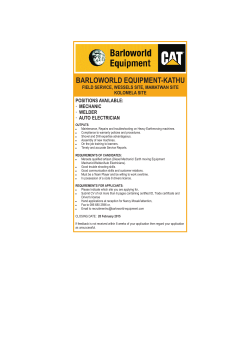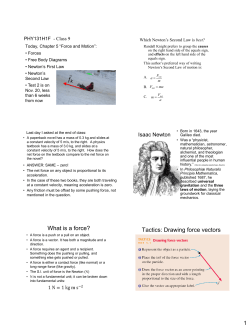
ID CODE: B Physics 201 Midterm Exam 2 October 27
ID CODE: B Physics 201 Midterm Exam 2 October 27th, 2014 Name: ............................................... Student ID: ......................... Section: ......................... TA (please circle): Jonathan Brown Steven Casper Yu Huang Benjamin Lemberger Patrick Vanmeter Nicole Vassh Brandon Wilson Instructions: 1. Donʼt forget to write down your name, student ID#, and section number. You need do this on (this page of) your test book and on your Scantron sheet as well. 2. Answer all multiple choice questions in this test book by indicating the best answer among choices. You must do this both on your test book and on your Scantron sheet. Follow instructions on the Scantron sheet on how to mark valid answers. 3. When you finish, you need to turn in both this test book and the Scantron sheet. 4: Use the blank side of question pages as additional draft spaces. An extra blank sheet is provided at the end of the test book. 5: Only one answer is allowed per problem/question. All problems have equal weight. Constants: g=9.8 m/s2 (Note: Neglect air friction for all projectile motion). Please be very careful with the first question even though the answer will not count towards your grade: 1. ENTER THE ID CODE ABOVE IN THE UPPER RIGHT CORNER A. ID Code A B. ID Code B C. ID Code C D. ID Code D E. ID Code E 2. Consider a process in which a wood block is moving up along a slope. The block is subject to four forces: its weight, the normal force from the slope, the kinetic friction and a non-conservative pushing force. It is known that in the process the work done by its weight is -40J, by the pushing force is 70J, and by the friction is -20J. Which of the following statements is true regarding the block-earth system’s energies at the end of this process? a. b. c. d. e. the system’s kinetic energy increases but its mechanic energy decreases. the system’s kinetic energy decreases but its mechanic energy increases. both its kinetic and mechanic energy decrease. both its kinetic and mechanic energy increase. None of above is true. 3. The systems shown below are in equilibrium with m = 1.70 kg. The spring scale is calibrated in newtons, what does it read? Ignore the masses of the pulleys and strings and also ignore all frictions. a. b. c. d. e. 1.7 N 16.7 N 33.4 N 3.4 N none of above is within 5% from the correct answer. 4. A car of 100 kg on a frictionless roller coaster track is sliding down from height of 10m to the ground. What is the total work done on the car during this 10m descending? (ignore all friction). a. b. c. d. e. Zero 9.8 kJ -9.8 kJ 4.9 kJ None of above is within 0.5 kJ of the correct answer. 5. The gravitational force exerted on a baseball is 2.24 N down. A pitcher throws the baseball horizontally with velocity 14.0 m/s by uniformly accelerating it along a straight horizontal line for a time interval of 187 ms. The ball starts from rest. What is the direction of the force the pitcher exerts on the ball? a. b. c. d. e. 7.5o above the horizontal 15o above the horizontal 23o above the horizontal 0o , i.e. horizontally None of above is within 10% of the correct answer. 6. An object is observed to have an acceleration in a direction θ = 54.5° east of north. The figure below shows a view of the object from above. The force F2 acting on the object has a magnitude of 6.10 N and is directed north. Determine the magnitude of the force F1 acting on the object a. b. c. d. e. 8.6 N 11.3 N 4.7 N none of above is within 0.2 N from the correct answer. It cannot be determined as neither the mass nor the magnitude of the acceleration is given. 7. A bead of m=4.6 g slides without friction around a loop–the–loop (see figure below). The bead is released from rest at a height h. a. b. c. d. e. If h= 3.70R, How large is the normal force on the bead at point “A” ? 0.11 N 0.045 N 0.24 N none of above is within 5% from the correct answer. Not enough information as the value of R is not given. 8. Two blocks, each of mass m are hung from the ceiling of an elevator as in the figure below. The elevator moves with an upward acceleration. What can we say about the tensions T1 and T2 in comparison? a. b. c. d. e. T1= 2T2 2T1= T2 T1= T2 Can not be determined as the magnitude of the acceleration is not given None of above is correct. 9. Still with the above setting, it is known that the mass of each block is 3.45 kg. If the strings can withstand a maximum tension of 86.6 N, what maximum acceleration can the elevator have before a string breaks? a. b. c. d. e. 9.8 m/s2 7.2 m/s2 1.3 m/s2 2.8 m/s2 None of above is with 5% from the correct value. 10. A coin placed 29.6 cm from the center of a rotating horizontal turntable starts to slip when its speed is 50.2 cm/s. What is the coefficient of static friction between coin and turntable? a. 0.065 b. 0.087 c. 0.283 d. 0.387 e. none of above is within 0.005 from the correct answer. 11. Two blocks of mass m1 = 2.00 kg and m2 = 6.50 kg are connected by string that passes over a pulley (see the figure below). The string is massless and inextensible. Initially, the blocks are held still by an external force and after the external force is removed, the blocks start to move. What is the acceleration of m1 when it is moving? (Ignore all frictions) a. b. c. d. e. 1.53 m/s2 up slope 1.53 m/s2 down slope 2.98 m/s2 up slope 2.98 m/s2 down slope None of above is within 10% from the correct answer. 12. In the setting above, consider the Blocks-Earth system. As the blocks are moving, what can we say about the system’s energies? a. The system’s potential energy increases but the system’s mechanic energy remains unchanged. b. The system’s potential energy decreases but the system’s mechanic energy remains unchanged. c. Both the system’s potential and mechanic energy remain unchanged. d. Both the system’s potential and mechanic energy increase. e. Both the system’s potential and mechanic energy decrease. 13. A car of a total mass 1200 kg (including passengers) is climbing up a slope of 18o at a constant speed of 5.0 m/s. What is the (minimum) power its engine has to provide to maintain this speed? a. b. c. d. e. 7.3 kW 9.5 kW 14.7 kW 18.2 kW none of above is within 0.2kW from the correct answer. 14. A particle of mass M, attached by a string with one fixed end at center C, is undergoing a circular motion on a smooth horizontal table. (See left figure below for a top view). At the moment when the particle is passing the point B, the string is suddenly cut at the cutting point x as shown in the right figure above. Viewing from the top, which is the trajectory of the particle after the cut? a. Still the same circular course as shown by dashed trajectory 1 in the right figure above. b. A less curved course as shown by dashed trajectory 2. c. A straight-line tangent to the original circle (dashed trajectory 3.) d. The trajectory will now bend outwards due to the original circular inertia (dashed trajectory 4) 15. Two children stand on a platform at the top of a curving slide next to a backyard swimming pool. They decide to get into water in different way. The bigger (and heavier) child chooses to slide on through the frictionless slide, and the smaller child simply hops off to jump straight down into the pool. Upon reaching the water, a. b. c. d. e. The bigger kid has higher kinetic energy and higher speed. The bigger kid has higher kinetic energy but lower speed. The bigger kid has lower kinetic energy but higher speed. Both kids have the same kinetic energy and the same speed. None of above is true. 16. A block M = 0.93 kg is pulled up along an inclined plane by a constant force F. The coefficient of kinetic friction between the block and the plane surface µk=0.30. The block starts from rest at the bottom. The block’s speed is 7.38 m/s when it reaches the top. How big is the force F? (hint: you can use Newton’s 2nd law, but an energy approach would be easier.) a. b. c. d. e. 18.4N 12.1 N 16.7 N 22.3 N none of above is within 0.3N from the correct answer. 17. The figure below shows the speed of a person's body as he does a chin-up. Assume the motion is vertical and the mass of the person's body is 69.2 kg. what is (the magnitude of) the force exerted by the chin-up bar on his body at t=1.5s. a. b. c. d. e. 3474 N 720 N 678 N 637 N none of above is within 5% from the correct answer. 18. A block is set into motion up an inclined plane with an initial speed of vi = 7.80 m/s. The block comes to rest after traveling d = 3.00 m along the plane, which is inclined at an angle of θ = 18.0° (figure below). What is the coefficient of kinetic friction between the block and the plane surface? (hint: you can use Newton’s 2nd law, but an energy approach would be easier.) a. b. c. d. e. 0.34 0.26 0.62 0.48 none of above is within 5% from the correct answer. 19. An object of mass m = 0.570 kg is suspended from the ceiling of an accelerating truck as in the figure below. Take a = 2.40 m/s2. Find the angle θ that the string makes with the vertical. a. b. c. d. e. 14.2o 18.3o 13.8o 15.7o none of above is within 0.2o from the correct answer. 20. A 10.0–kg block is released from rest at point “A” in the figure below. The track is frictionless except for the portion between points “B” and “C”, which has a length of 6.00 m. The block travels down the track, hits a spring of force constant 2 200 N/m, and compresses the spring 0.45 m from its equilibrium position before coming to rest momentarily. Determine the coefficient of kinetic friction between the block and the rough surface between points “B” and “C”. a. b. c. d. e. 0.07 0.12 0.25 0.33 none of above is within 10% from the correct answer. 21. In the previous setting, imagine the block will be going back and forth between the slope and the spring before coming to a complete stop. How many times will it pass point B (counting from when it is released from point A)? (hint: while you can, you may not need to use the answer from the previous problem.) a. b. c. d. e. 2 3 4 5 other
© Copyright 2025




















